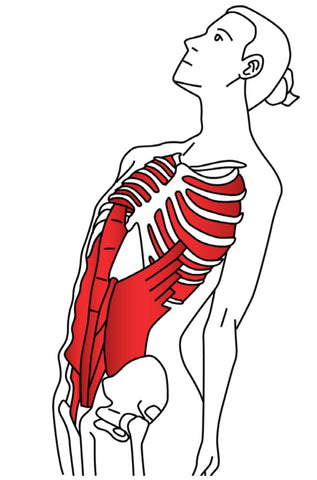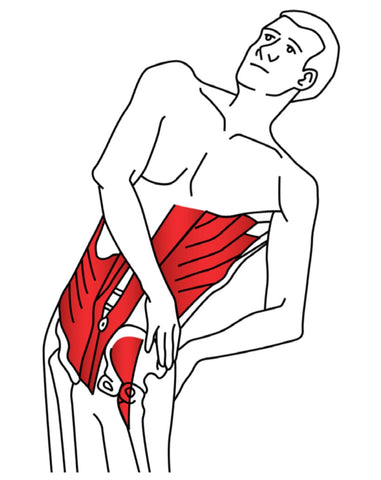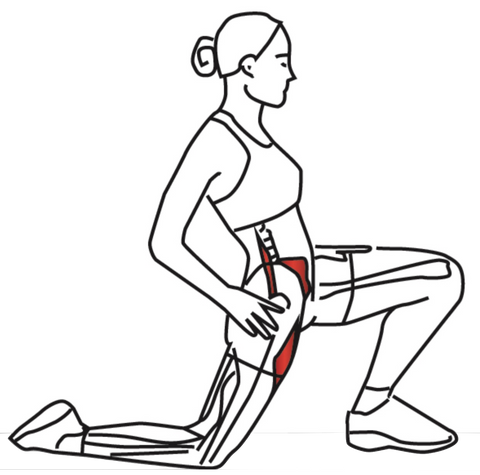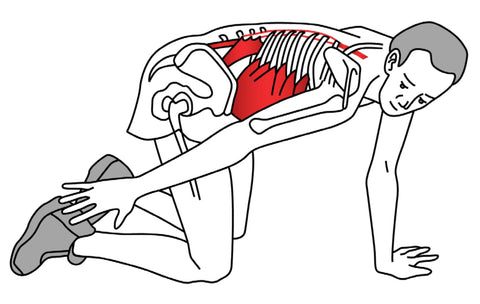Stretching for the Trunk and Spine
Rules for Safe Stretching - Stuart Hinds
Stretching is something that most of us should do daily - now could be a good time to start!
It's a simple fact that muscles and joints will become stiffer and tighter, simply as part of the aging process.
In most cases, this process is caused by a combination of physical degeneration and inactivity.
Although we cannot help getting older, this should not mean that we give up trying to improve our flexibility. In fact, quite the opposite!
Age does not have to be a barrier to an active lifestyle, but certain precautions should be taken as we get older.
We generally just need to work at it for longer, be a little more patient, and take a lot more care.
Stretching
Stretching is something that we should all do daily, and it's never too late to start.
There are many important benefits to be had, including:
- Improved range of motion
- Increased power
- Can help prevent latent trigger points from becoming active
- Diminished post-treatment soreness
- Reduced fatigue
Breaking Old Holding Patterns
Stretching the muscles with trigger points, or the muscles that you are trying to strengthen, is important for breaking old holding patterns, restoring range of motion, and preventing injury.
Gently stretching after a trigger point treatment session or immediately following sport or exercise activities can help reduce muscle soreness and help keep your muscles long and flexible.
Get moving today!
Below we've provided details of some really easy, but super-beneficial stretches for the trunk and spine that most people should be able to do at home.
Start by choosing 3 of these stretches and set aside just 5 minutes every day for a week to perform these as shown.
By doing this for 7 days straight, you'll start to feel more loose, and hopefully get hooked on the idea of maintaining a daily 5 minute stretching regime.
As you continue to feel the health benefits, try to extend your daily routine to 10 minutes and include more stretches for other parts of the body.
If you have any injuries or haven't exercised for a while, make sure to consult a suitably qualified health professional before you start your stretching regime.

Technique
- Stand upright with your feet shoulder width apart
- Place your hands on your buttocks for support
- Look upwards and slowly lean backwards
- Keep your legs sturdy
Avoid this stretch if you suffer from lower back pain or if you have sustained an injury to the lower back.
When performing this stretch for the first time, use caution and rest between each repetition.
Primary muscles
External and internal intercostals. External and internal obliques. Transversus abdominis. Rectus abdominis.
Secondary muscles
Psoas major and minor. Iliacus
Injury where stretch may be useful
Abdominal muscle strain. Hip flexor strain. Iliopsoas tendonitis.

Technique
- Stand upright with your feet shoulder width apart
- Place one hand on your buttocks for support
- Look up and slowly lean backwards
- Reach over with your opposite hand
- Rotate your upper body at the waist
Avoid this stretch if you suffer from lower back pain or if you have sustained an injury to the lower back. When performing this stretch for the first time, use caution and rest between each repetition.
Primary muscles
External and internal obliques. Transversus abdominis. Rectus abdominis.
Secondary muscles
Quadatus lumborum. Psoas major and minor. Iliacus.
Injury where stretch may be useful
Abdominal muscle strain. Hip flexor strain. Iliopsoas tendonitis.

Technique
- Kneel on one foot
- Place your hands on your hips
- Push your hips forward
- If necessary, hold on to something to keep balance
You can increase the intensity of this stretch by pushing your hips forward. If necessary, place a towel or mat under your knee for added comfort.
Primary muscles
Iliacus. Psoas major and minor.
Secondary muscles
Rectus femoris. Sartorius.
Injury where stretch may be useful
Hip flexor strain. Avulsion fracture in the pelvic area. Osteitis pubis. Iliopsoas tendonitis. Trochanteric bursitis. Quadriceps strain. Quadriceps tendonitis.

Technique
- Stand upright with your feet shoulder width apart
- Cross your arms and place your hands on your shoulders
- Slowly rotate your shoulders to one side
To increase the intensity of this stretch use your hands to help you rotate sideways.
Primary muscles
Semispinalis thoracis. Spinalis thoracis. Longissimus thoracis. Iliocostalis thoracis. Iliocostalis lumborum. Multifidus. Rotatores. Intertransversarii. Interspinales.
Secondary muscles
Quadratus lumborum. External and internal obliques.
Injury where stretch may be useful
Back muscle strain. Back ligament sprain. Abdominal muscle strain (obliques).

Technique
- Kneel on all fours
- Support yourself with one hand and reach towards your ankle with the other
- Keep your back parallel to the ground
Keep your back straight, parallel to the ground, and your thighs in a vertical position.
Distribute your weight evenly on both your hands and knees.
Primary muscles
Quadratus lumborum. External and internal obliques.
Secondary muscles
Iliocostalis lumborum. Intertransversarii. Rotatores. Multifidus.
Injury where stretch may be useful
Lower back muscle strain. Lower back ligament sprain. Abdominal muscle strain (obliques).
Find a Trigger Point Professional in your area
Dry Needling for Trigger Points
Certify as a Trigger Point Therapist
This trigger point therapy blog is intended to be used for information purposes only and is not intended to be used for medical diagnosis or treatment or to substitute for a medical diagnosis and/or treatment rendered or prescribed by a physician or competent healthcare professional. This information is designed as educational material, but should not be taken as a recommendation for treatment of any particular person or patient. Always consult your physician if you think you need treatment or if you feel unwell.

Continuing Professional Education
Looking for Massage Therapy CEUs, PT and ATC continuing education, chiropractic CE, or advanced manual therapy training? Explore our evidence-based online courses designed for hands-on professionals.




















